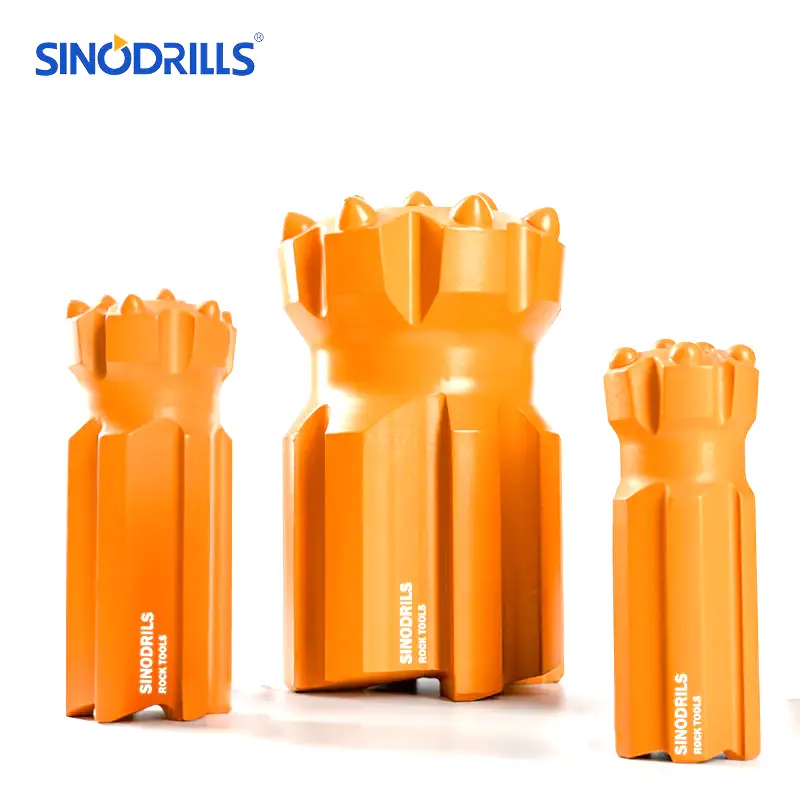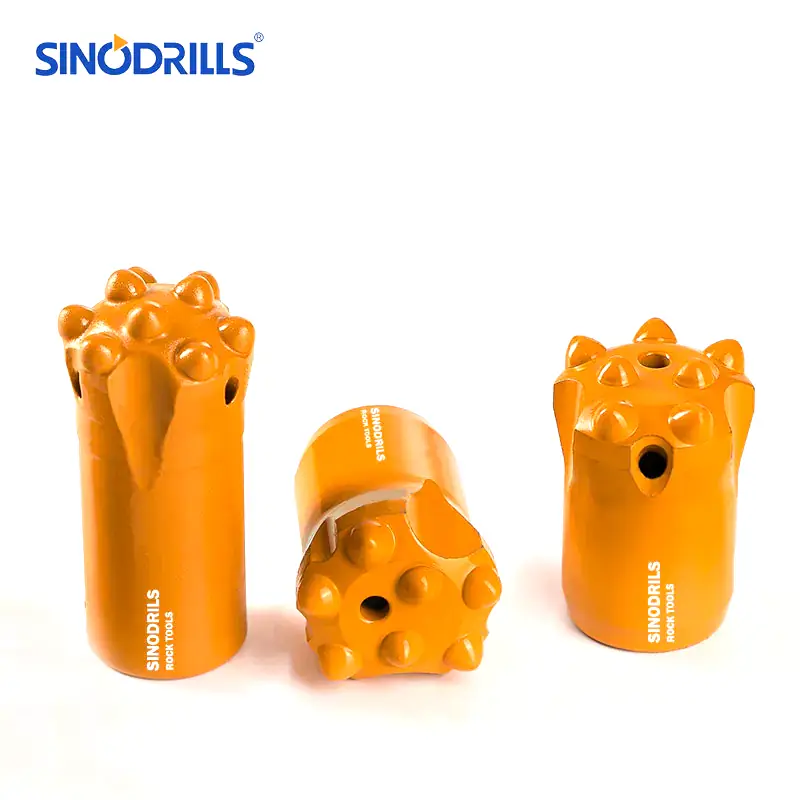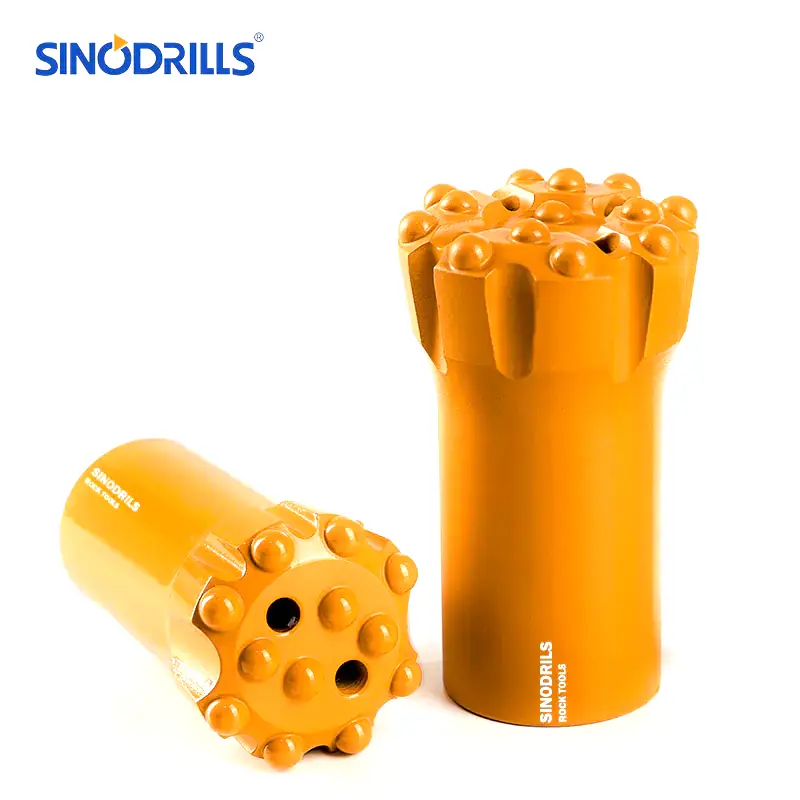Choosing the right drill is crucial for project success, especially when tackling tough materials like concrete or rock. Many wonder about the fundamental difference between a hammer drill and a regular drill. While both tools rotate a bit, their internal mechanisms and intended applications set them miles apart. Understanding these core distinctions is key to maximizing efficiency and selecting the right equipment.
The primary difference lies in the impact mechanism. A regular drill relies solely on rotational power, making it ideal for soft materials like wood, metal, and plastic. In contrast, a hammer drill adds a powerful, forward-and-backward pounding action, enabling it to easily penetrate hard surfaces like concrete, masonry, and rock. This crucial feature determines which tool is best for your heavy-duty tasks.
What are Hammer Drill Bits?
Hammer drill bits, especially those used for professional rock drilling, are highly specialized tools designed to withstand intense percussive and rotational forces. They are the cutting element in a hammer drilling system, which uses rapid, high-frequency blows combined with rotation to pulverize the toughest materials, such as granite, quartzite, and hard concrete.
These bits are engineered with premium materials and geometry to handle extreme rock formations, ensuring high penetration rates and extended service life in mining, quarrying, and construction applications. Their design is a key factor in transferring the impact energy from the drill hammer directly to the rock face, breaking it efficiently.
- Tungsten Carbide Inserts (Buttons): These are the extremely hard cutting elements, often spherical or ballistic in shape, pressed into the bit face. They withstand tremendous impact and abrasion, shattering rock upon contact to ensure maximum penetration and bit longevity.
- DTH (Down-The-Hole) Hammer Bits: Specifically designed for DTH systems, these bits work at the bottom of the borehole, receiving powerful impacts directly from the air-driven hammer piston. This design provides superior energy transfer for fast, straight drilling in very hard and deep rock formations.
- Flute and Face Design: Hammer drill bits feature deep flutes or multi-cutter head designs (like cross or X-bits) that aggressively clear rock chips and dust. Efficient debris removal is crucial to prevent clogging, reduce friction, and maintain the maximum drilling speed and overall efficiency.
- Shank Compatibility (e.g., SDS-Max, Threaded): The shank end of the bit is engineered to precisely fit the hammer drill chuck system, such as SDS-Max for heavy-duty rotary hammers or threaded connections for top-hammer rigs. This connection secures the bit and ensures optimal transmission of both rotational torque and impact energy.
What are Regular Drill Bits?
Regular rock drill bits are the essential cutting tools used with various rock drilling machines, designed to break and penetrate rock formations through percussion, rotation, or a combination of both. Their design and material composition are specifically engineered to fracture, chip, or grind away rock, making them indispensable for construction, mining, and quarrying projects in diverse geological conditions.
These bits come in a variety of configurations, tailored for different rock hardness and drilling methods. The cutting elements are typically made from extremely hard materials to withstand the abrasive nature of rock. Selecting the correct bit is vital to ensure optimal penetration rate and bit longevity, significantly impacting overall project efficiency.
- Tapered Bits: These are conical in shape and are often used for hard rock formations like granite. Their design promotes deep penetration when paired with hammer drills, making them a common choice in both underground and surface hard rock applications. They come in various sizes for precision.
- Cross-Type Bits: Featuring a chisel-shaped tungsten carbide tip arranged in an ‘X’ pattern, these are built for drilling through hard and highly abrasive rock formations. Their robust design provides excellent wear resistance and is frequently used in demanding deep-hole mining and construction operations.
- Button-Type Bits: Equipped with tungsten carbide buttons pressed into the bit face, these deliver a powerful, concentrated impact force. They are highly efficient for shallow to medium-depth drilling into hard stone, concrete, and rock, providing a balance of speed and extended bit life.
- PDC (Polycrystalline Diamond Compact) Bits: These are fixed-cutter bits that utilize a shearing action, employing diamond-enhanced cutters to grind through the rock. PDC bits excel in drilling through softer-to-medium rock formations like shale and soft limestone, offering fast penetration rates and exceptional durability.
Hammer Drill vs Regular Drill
Selecting the appropriate tool is paramount for effective drilling. The key distinction between a hammer drill and a regular drill lies in their mechanism, purpose, and the materials they are designed to penetrate efficiently. Understanding these core differences ensures you choose the right power tool for your specific task, especially when dealing with tough surfaces like concrete or rock.
Core Mechanism and Action
A regular drill operates solely on a rotary action, spinning the drill bit to cut into materials. It provides high rotational speed but relies entirely on the sharpness of the bit and the user’s pressure to penetrate the surface. This single-action mechanism makes it an excellent choice for tasks that require precision and clean cuts.
In contrast, a hammer drill combines this rotary action with a powerful, high-frequency percussive or “hammering” action. Inside the tool, two ribbed plates engage to cause the chuck and the bit to rapidly punch forward and backward. This simultaneous rotation and impact fractures hard materials, pulverizing them while the rotation clears debris.
Intended Materials and Applications
The regular drill is the versatile workhorse, designed for drilling holes in soft-to-medium density materials. These applications include wood, thin metal, plastic, and drywall. It is the go-to tool for general DIY projects, assembling furniture, and driving screws, where excessive force is neither needed nor desirable.
The hammer drill is specifically engineered for hard materials like concrete, masonry, brick, and rock. The added impact mechanism allows it to quickly penetrate these dense surfaces that would quickly dull or stall a regular drill. It is essential for heavy-duty installation of anchors, setting bolts in concrete, and construction tasks.
Drill Bit Requirements
Regular drills utilize standard drill bits, such as twist bits for metal and wood, spade bits for larger holes in wood, and sometimes carbide-tipped masonry bits for very light masonry work. These bits are simply held securely in the chuck and rotate without any specialized requirements for impact tolerance.
Hammer drills, when used in hammer mode, require specialized masonry bits that feature a tungsten carbide tip specifically designed to withstand the percussive blows. For the most powerful rotary hammers (a step up from hammer drills), an SDS or SDS-Max bit system is used, allowing the bit to slide independently to maximize the hammering force.
Drilling Speed and Efficiency
For soft materials, a regular drill is faster and more efficient, as its precision and high rotational speed are perfectly suited for cutting. Using a hammer drill on soft material, even without the hammer function, can be cumbersome due to the tool’s extra weight and bulk.
The hammer drill drastically outperforms the regular drill in hard materials. The impact action dramatically increases the rate of penetration (ROP) into concrete and stone. While a regular drill might take minutes to drill a small hole in brick, a hammer drill can complete the same task in a matter of seconds, saving significant time and effort.
Noise and Vibration
The regular drill is typically the quieter of the two tools, producing a consistent whirring sound during use. It generates minimal vibration, making it comfortable for extended operation, particularly for detailed work that requires a steady hand.
Operating a hammer drill in the impact setting produces a very loud, sharp, rapid buzzing or chattering sound. The powerful, high-frequency impacts also generate considerable vibration, which can lead to user fatigue more quickly. Extended use may require the operator to wear hearing protection and vibration-dampening gloves.
Comparison of Key Features
| Feature | Regular Drill | Hammer Drill |
| Core Mechanism | Rotation only | Rotation plus Percussion (Hammering) |
| Primary Use | Wood, Metal, Plastic, Screwdriving | Concrete, Brick, Stone, Masonry |
| Required Bits | Standard twist, spade, pilot bits | Carbide-tipped Masonry bits (in hammer mode) |
| Speed in Hard Materials | Very Slow, ineffective | Fast, highly efficient |
| Vibration/Noise | Low | High |
| Versatility | High (general use, driving screws) | Medium (versatile when hammer mode is off) |
How to Choose Hammer Drill and Regular Drill?
Choosing between a hammer drill and a regular drill depends entirely on your project’s materials and scope. A regular drill is ideal for general, precision tasks, while the hammer drill is essential for breaking through hard masonry. Consider the frequency and difficulty of your drilling jobs to select the most appropriate and cost-effective tool for your needs.
- Material: If you are drilling into concrete, brick, or stone, choose a hammer drill (or rotary hammer); for wood, metal, or drywall, a regular drill is sufficient and better.
- Mechanism: A regular drill uses only rotation to cut a hole; a hammer drill adds a rapid hammering action in the direction of the bit to pulverize hard material.
- Functionality: Many hammer drills have a switch to turn off the hammer mode, making them function as a regular drill, offering versatility for diverse home projects.
- Cost & Weight: Regular drills are generally lighter and less expensive, making them ideal for everyday, light-duty work; hammer drills are heavier and cost more due to their added mechanism.
- Bit Type: A regular drill uses standard drill bits; a hammer drill requires carbide-tipped masonry bits to withstand the powerful, repetitive impacts into hard materials.
Conclusion
Ultimately, the choice between a hammer drill and a regular drill depends entirely on your project material. For softer materials like wood or metal, the versatility, lightweight design, and precision of a regular drill are unmatched and sufficient. However, when faced with demanding tasks like deep hole rock drilling, concrete work, or tough masonry, the percussive power of the hammer drill is essential for both speed and effectiveness.
The hammer drill’s unique impact mechanism makes it indispensable for professional and heavy-duty work, ensuring holes are drilled quickly and accurately into the hardest surfaces you encounter. Using the correct tool not only guarantees a successful result but also significantly saves time, reduces physical effort, and preserves the lifespan of your drill bits and equipment over time.
To equip yourself for any drilling challenge, ensure you have a comprehensive inventory of reliable, high-performance tools and bits. For all your large-scale or wholesale requirements, you can get wholesale drilling tools directly from Sinodrills. We supply a complete range of quality hammer drills, regular drills, and specialized rock drilling components to maximize your project’s productivity and profitability.





